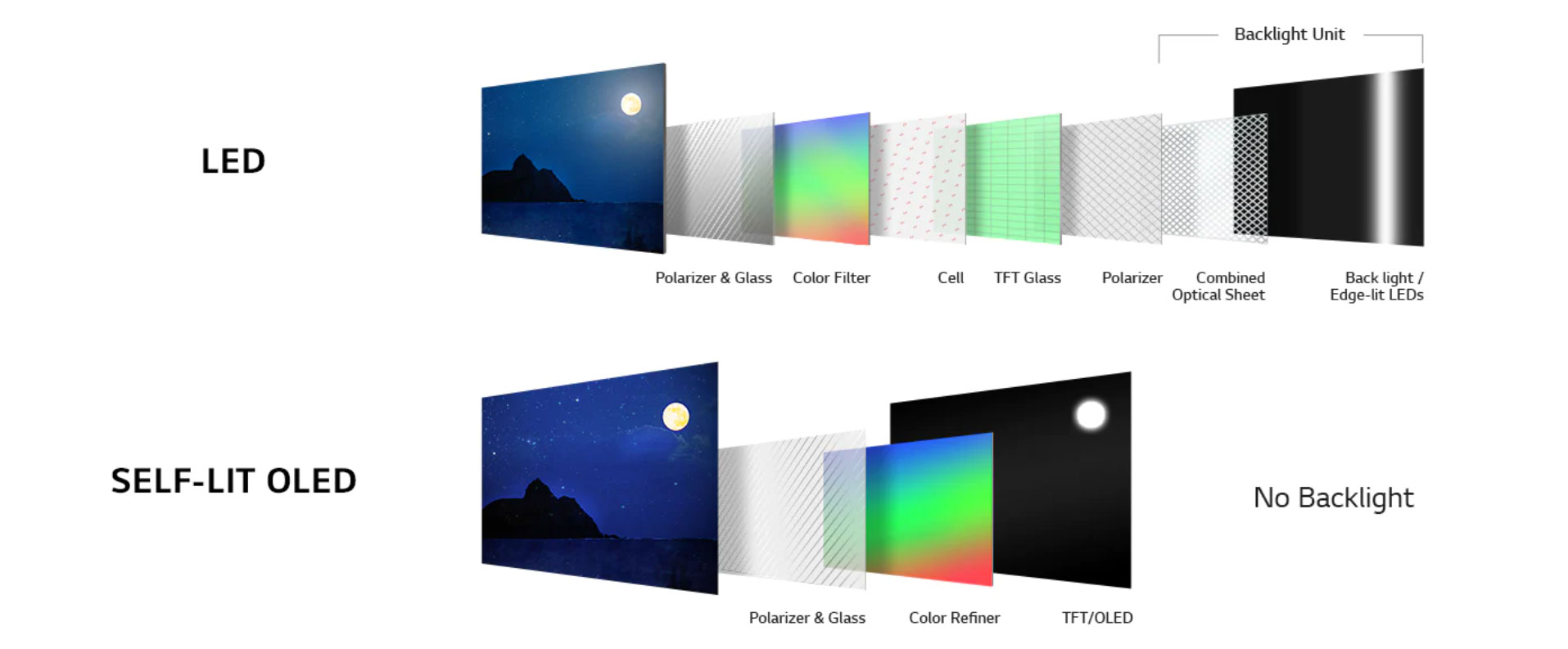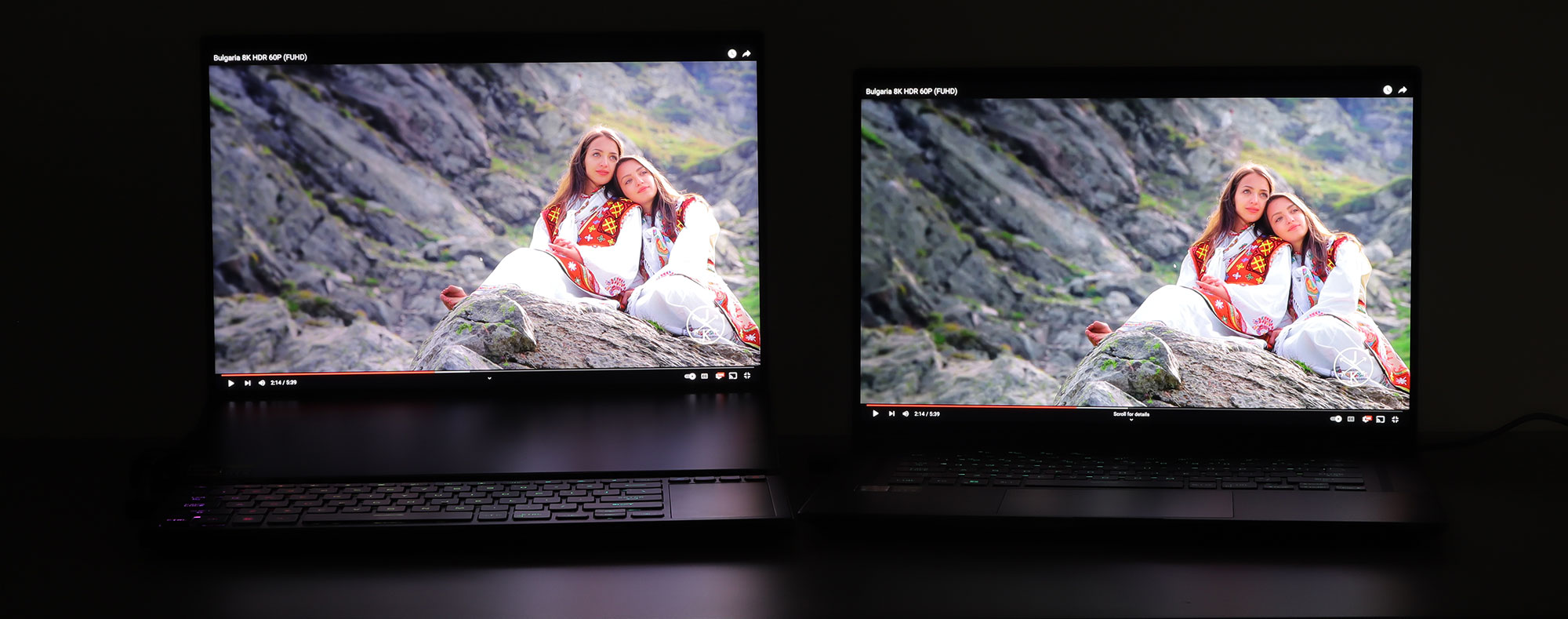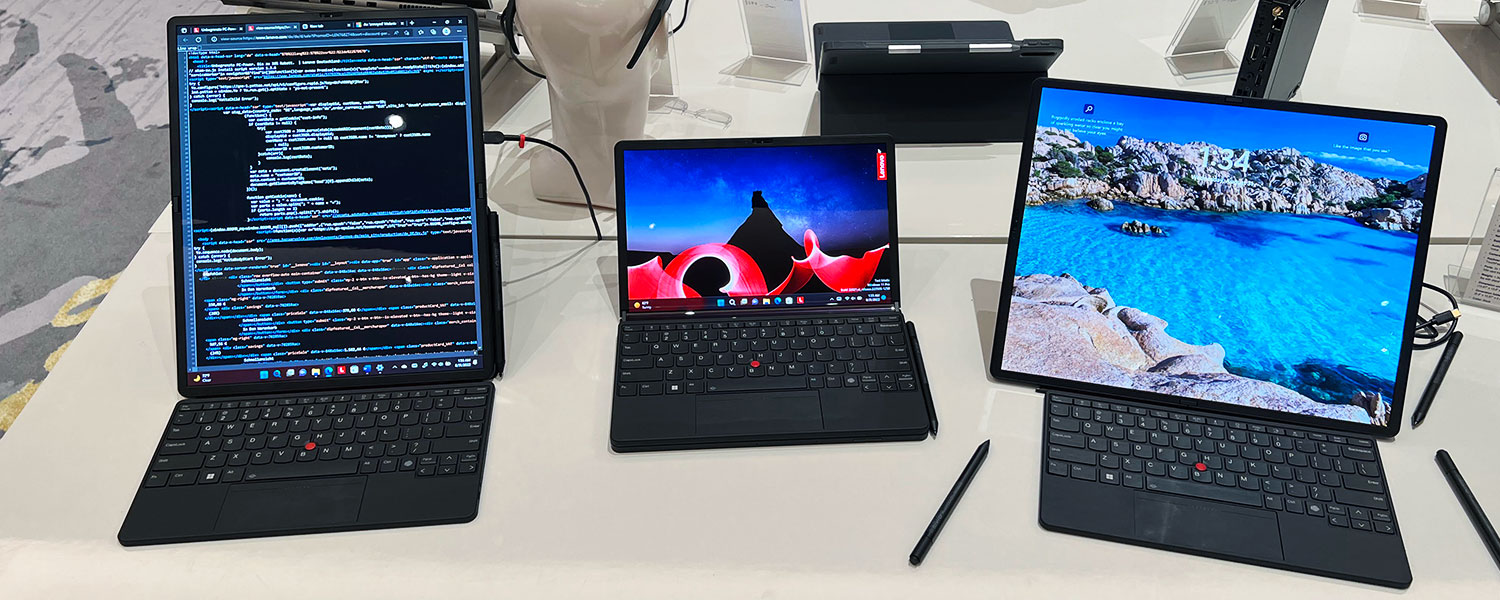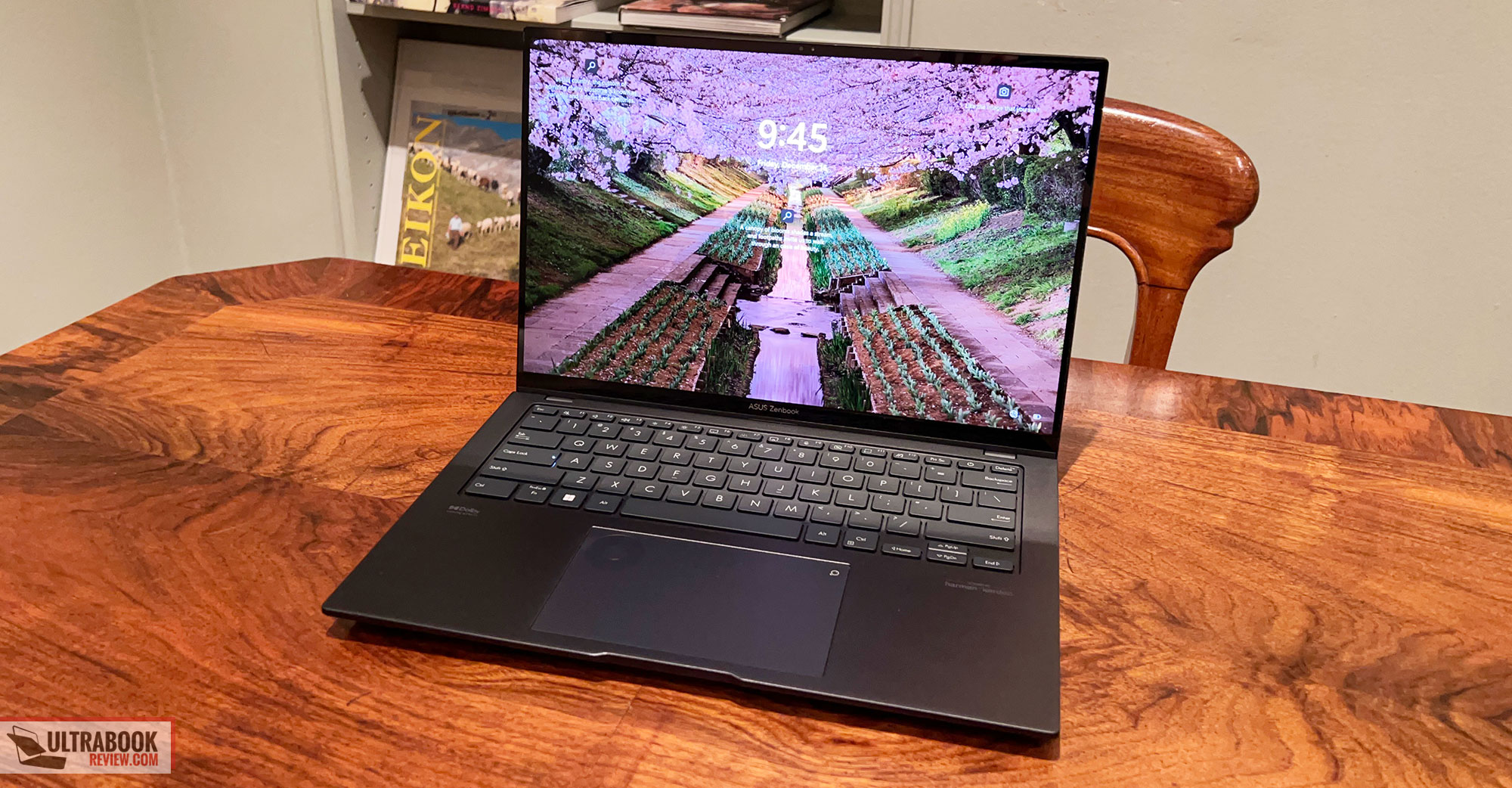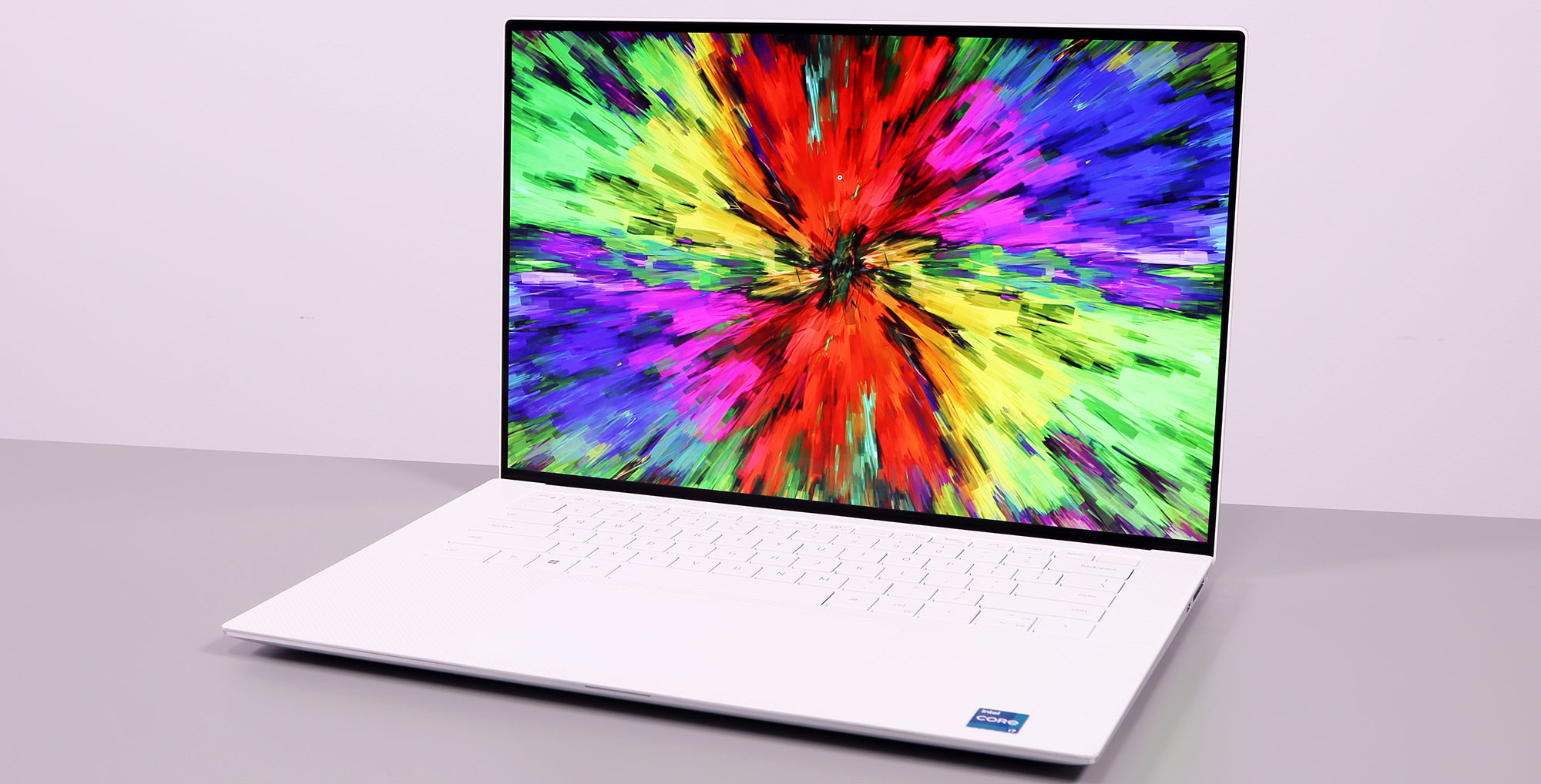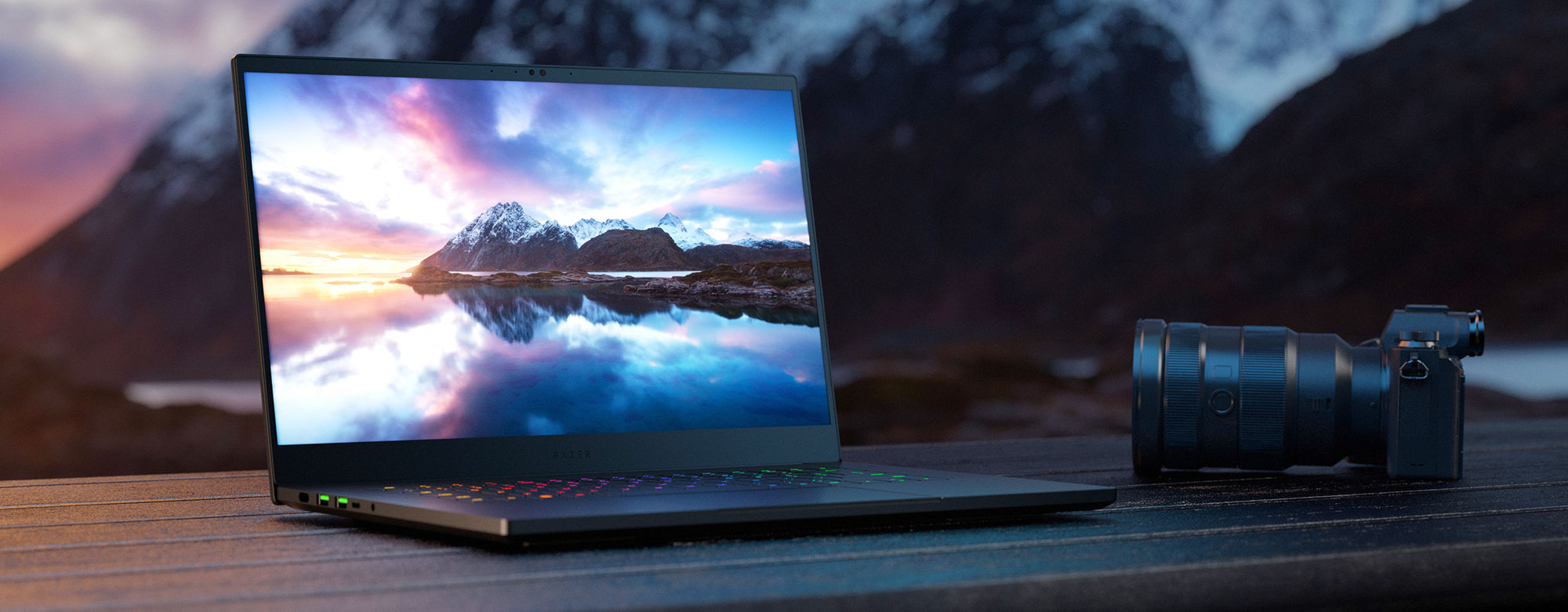More and more OLED laptops are available in stores these days, of all sizes and kinds.
In this article, I’m going to explain the particularities of the OLED displays available on modern laptops, with their main selling points such as their beautiful image quality with punchy colors, pitch-dark blacks, and unmatched contrast, but also the quirks that you must understand and accept when buying one of these OLED notebooks.
I’ll also reference some of the other types of laptop displays, such as LED IPS and mini LED, for comparison with what OLEDs offer.
That aside, I’ve also compiled down below a few detailed lists of several types of notebooks available with OLED displays, as well as Best of summarized sections for each category. We’ll go over portable and compact OLED ultrabooks, mid-tier laptops for general use and for most budgets, as well as powerful OLED gaming and work computers. We’ll also touch on some of the most recent launches with 3D OLED displays, dual-displays, or foldable OLED screens.
OLED technology explained, vs. LED IPS, mini LED
OLED panels have been available on multiple devices for the last year, and while they’re most popular on TVs and smartphones, they’ve also gained ground on notebooks as well.
As of 2023, Samsung makes the majority of OLED panels for laptop use, in sizes varying from 11 to 17 inches, and the price of OLED laptop screens has gone down a fair bit, allowing OEMs to implement this display technology on a wide range of products (including affordable models).
Unlike other display technologies, OLED panels are made from millions of individual self-lit OLEDs (organic light-emitting diode). Each pixel in an OLED display is an individual light diode, and can be controlled independently from the others around.
Thus, OLED panels have millions of individually controllable pixels, unlike LED panels that only offer up to thousands of LED light sources in their best implementations.
This allows the technology to display the most accurate images and content, with excellent blacks, excellent contrast, and none of the blooming/glowing artifacts noticeable with LED panels. The simpler structure of OLED displays also allows them to be implemented in thinner devices, as well as in devices with flexible screens.
At the same time, though, the diodes are an organic compound and can degrade over time. However, modern panels are guaranteed to work for 30000 hours within specs (which is equivalent to 7 years of use for 12 hours each day), so you shouldn’t be concerned about these diodes degrading over time, as long as you’re not misusing your device. We’re going over the advantages and downsides of OLED technology further down, as well as some indications on how to prevent image retention and burn in.
I’ll also add here that OLED displays are mostly implemented on regular laptop formats these days, but with some notable exceptions:
- foldable notebooks with flexible OLED screens (which will be followed up by other rollable/foldable/flexible implementations based on the known concepts and prototypes);
- dual-screen OLED notebooks;
- glass-free 3D OLED implementations.
I’ll update this section as new technologies become available on retail products (hopefully QD-OLED – Quantum Dot OLED – makes its way into some models as well).
For comparison, LCD LED panels (TN, IPS LED, mini LED, etc) work entirely differently. They utilize a backlighting source that shines light through a complex substrate of RGB liquid crystals in order to create images. The light source differs between panels, from an edge-lit LED source of the cheapest options, to an array of thousands of mini LEDs on the most advanced options.
Most laptops available these days offer IPS LED panels with full-array lighting, but without dimming capabilities. Some of the premium options are available with mini LED panels, which offer higher brightness, better contrast, and better overall image quality than the regular LEDs, through zone dimming control. This dedicated article explains the mini LED technology implemented on some laptops these days.
Down below I’ve included an image of a mini LED panel (left) next to an OLED panel (right), both running an 8K HDR clip. The miniLED gets brighter, but also shows some blooming and burns out some of the details, while the same details are more accurately represented on the OLED. Blacks and Contrast are also superior on the OLED, but this one doesn’t run as bright as the mini LED (600-nits peak HDR – OLED vs 1100-nits peak HDR – miniLED).
We’ll also have a more thorough separate article that compares OLED, IPS, and mini LED displays, with more real-life examples from our reviews.
Why would you want an OLED laptop?
OLED panels are highly versatile on laptops because:
- offer pretty much the best available image quality for mixed use (daily, work, gaming);
- they allow for perfect blacks and contrast unmatched by any other display technology available today in laptops (since micro LED is not yet an option);
- they don’t suffer from vignetting, light bleeding, or blooming/glowing on contrasting elements;
- emit low blue-light levels even at higher brightness (with TUF certifications);
- allow the colors to be perceived more vividly at lower brightness levels than on other panel technologies;
- offer uniform luminosity and colors, alongside wide color gamut coverage (100% DCI-P3) on most variants;
- offer very fastest response times on all variants (sub 1 ms), as well as excellent 240Hz refresh on a few gaming OLED notebooks.
The downsides and quirks of OLED panels on laptops
At the same time, there are some particularities that you need to understand about OLEDs before getting one on your laptop:
- the organic diodes age over time and can suffer from burn-in (image retention), especially if misused (details below);
- OLED panels are not very bright, at around 400-nits SDR and 600-nits peak HDR;
- can suffer from black crush and grey banding;
- some implementations might experience a degree of flickering at lower brightness settings;
- are only available in glossy implementations;
- suffer from graininess on touch implementations (but only on the variants with a digitizer layer);
- most OLED options are only 60-120Hz refresh at this point.
Burn-in is what concerns most people when it comes to OLED panels, but this is mostly impacting older-generation OLEDs, and is less of an issue on the ones available in 2022-2023 (and later). The technology has been refined over time, and most OEMs implement various tricks designed to prevent image retention and pixel degradation, such as pixel shift, pixel refresh, and others.
Nonetheless, I wouldn’t totally dismiss the potential of OLED burn-in even on a modern device, so I advise you not to use an OLED laptop at max brightness for longer periods of time, especially while displaying static content. I’d also use the dark Windows theme and activate interface transparency in Windows 10/11 on an OLED device.
However, my main personal nit with the technology is the graininess that I find very annoying when reading/editing texts – this is only an issue on the touch OLED screens, and not on the non-touch variants, and it’s a side-effect of the way current Samsung-made OLED touchscreens implement the digitizer layer. Some of the available laptops are not using Samsung OLED panels, though, and some don’t implement a digitizer, thus don’t suffer from this graininess nuisance.
That aside, I dislike the fact that OLEDs only come in glossy glary finishes for now, as a matte coating that would not noticeably impact the color volume has not yet been developed. Some manufacturers mention anti-flare finishes on their OLEDs, but even those are reflective. Paired with the limited OLED brightness, these aspects are especially bothering on ultraportable laptops that you plan to use outdoors or in bright light environments.
List of OLED ultrabooks, portable laptops with OLED displays
This section includes all the available OLED ultrabooks and portable laptops with 14-inch and smaller displays.
There are quite a few such options available out there, from most OEMs, starting with affordable models and going all the way up to premium OLED convertibles and 4K OLED ultrabooks, as well as some powerful 14-inch models.
I’ve only included the latest devices in this list, and not some of the older ones that have been updated with recent hardware in the meantime (this means you will find in stores some other variants of some of these models, with previous-gen specs).
Furthermore, unless mentioned otherwise, the OLED panels on these laptops are all 400-nits SDR brightness, 600-nits peak HDR brightness, and 100% DCI-P3 gamut coverage.
| Model (link to reviews) | Type | Hardware | Screen |
| Acer Swift 3 | Ultrabook, mid-range | Intel Core H + Iris Xe | 14″ OLED, 16:10 format, glossy, non-touch, 2.8K 2880 x 1800 px, 90Hz, without digitizer |
| Acer Swift GO 14 | Ultrabook, mid-range | Intel Core H + Iris Xe | 14″ OLED, 16:10 format, glossy, non-touch, 2.8K 2880 x 1800 px, 90Hz, without digitizer |
| Acer Swift X 14 | Ultrabook, Creator | Intel Core H + up to RTX 4050 | 14″ OLED, 16:10 format, glossy, touch, 2.8K 2880 x 1800 px, 120Hz |
| Asus ExpertBook B9 B9403 | Business | Intel Core P + Iris Xe | 14″ OLED, 16:10 format, glossy, touch or non-touch, 2.8K 2880 x 1800 px, 90Hz |
| Asus VivoBook 14 | Ultrabook, mid-range | Intel Core U or H + Iris Xe | 14″ OLED, 16:10 format, glossy, non-touch, 2.8K 2880 x 1800 px, 90Hz |
| Asus ZenBook S 13 | Ultrabook, premium | AMD Ryzen U + Radeon | 13.3″ OLED, 16:9 format, glossy, touch, 2.8K 2880 x 1800 px, 60Hz |
| Asus ZenBook 14 | Ultrabook, mid-range | Intel Core P + Iris Xe, AMD Ryzen H + Radeon |
14″ OLED, 16:10 format, glossy, touch or non-touch, 2.8K 2880 x 1800 px, 90Hz |
| Asus ZenBook Flip 14 | Ultrabook, 2-in-1 | Intel Core H + Iris Xe | 14″ OLED, 16:10 format, glossy, touch, 2.8K 2880 x 1800 px, 90Hz |
| Asus ZenBook 14X | Ultrabook, premium | Intel Core H + up to RTX 4050 | 14.5″ OLED, 16:10 format, glossy, touch, 2.8K 2880 x 1800 px, 120Hz |
| Asus ZenBook Pro 14 | Creator, premium | Intel Core H + up to RTX 4070 80W | 14.5″ OLED, 16:10 format, glossy, touch, 2.8K 2880 x 1800 px, 120Hz |
| Asus ZenBook Pro DUO 14 | Creator, two screens | Intel Core H + up to RTX 4060 65W | 14.5″ OLED, 16:10 format, glossy, touch, 2.8K 2880 x 1800 px, 120Hz – main display IPS secondary display |
| Asus ZenBook Fold 17 | Foldable | Intel Core U + Iris Xe | 17.3″ OLED, 4:3 format, glossy, touch, 2.5K 2560 x 1920 px, 60Hz |
| Dell XPS 13 Plus | Ultrabook, premium | Intel Core P + Iris Xe | 13.4″ OLED, 16:10 format, anti-reflect, touch, 3.5K 3456 x 2160 px, 90Hz, without digitizer |
| HP Elite Dragonfly | Ultrabook, premium | Intel Core U + Iris Xe | 13.5″ OLED, 16:10 format, glossy, touch, 3K 2880 x 1800 px, 60Hz |
| HP Envy x360 13.3 | Ultrabook, 2-in-1, mid-tier |
Intel Core U + Iris Xe | 13.5″ OLED, 16:10 format, glossy, touch, 2.8K 2880 x 1800 px, 60Hz |
| HP Spectre x360 13.5 | Ultrabook, 2-in-1, premium |
Intel Core U + Iris Xe | 13.3″ OLED, 16:10 format, glossy, touch, 2.8K 3000 x 2000 px, 60Hz |
| HP Pavilion Plus 14 | Ultrabook, mid-range | Intel Core U + Iris Xe | 14″ OLED, 16:10 format, glossy, touch, 2.8K 2880 x 1800 px, 90Hz |
| Lenovo IdeaPad Slim 5 | Ultrabook, mid-range | Intel Core U/P + Iris Xe AMD Ryzen U + Radeon |
14″ OLED, 16:10 format, glossy, touch, FHD+ 1920 x 1200 px, 60Hz |
| Lenovo Chromebook Duet | Chromebook, tablet | Snapdragon + Adreno | 13.3″ OLED, 16:9 format, glossy, touch, FHD 1920 x 1080 px, 60Hz |
| Lenovo Tab P11 Pro | Tablet | Snapdragon + Adreno | 11.5″ OLED, 16:10 format, glossy, touch, 2.5K 2560 x 1600 px, 60Hz, 350-nits |
| Lenovo Slim 9i | Ultrabook, premium | Intel Core P + Iris Xe | 14″ OLED, 16:10 format, glossy, touch, 4K 3840 x 2400 px, 60Hz 2.8K 2880 x 1800 px, 90Hz |
| Lenovo Yoga 9i | Ultrabook, 2-in-1 | Intel Core P + Iris Xe | 14″ OLED, 16:10 format, glossy, touch, 4K 3840 x 2400 px, 60Hz 2.8K 2880 x 1800 px, 90Hz |
| Lenovo Yoga Book 9i | Ultrabook, 2-in-1 dual screens |
Intel Core U + Iris Xe | 13.3″ OLED, 16:10 format, glossy, touch, dual 2.8K 2880 x 1800 px, 60Hz |
| Lenovo ThinkPad X1 Yoga | Business, 2-in-1 | Intel Core P + Iris Xe | 14″ OLED, 16:10 format, glossy, touch, 4K 3840 x 2400 px, 60Hz, 500-nits |
| Lenovo ThinkPad T14s | Business | Intel Core P + Iris Xe AMD Ryzen U Pro + Radeon |
14″ OLED, 16:10 format, glossy, touch, 2.8K 2880 x 1800 px, 90Hz |
| Lenovo ThinkPad X1 Fold | Foldable | Intel Core U + Iris Xe | 16.3″ OLED, 5:4 format, glossy, touch, 2.5K 2560 x 2024 px, 60Hz |
| Lenovo ThinkPad X1 Yoga | Business, 2-in-1 | Intel Core P + Iris Xe | 14″ OLED, 16:10 format, glossy, touch, 4K 3840 x 2400 px, 60Hz, 500-nits |
| Lenovo ThinkPad Z13 | Business | AMD Ryzen U Pro + Radeon | 13.3″ OLED, 16:10 format, glossy, touch, 2.8K 2880 x 1800 px, 60Hz |
| LG Gram Style 14 | Ultrabook, premium | Intel Core P + Iris Xe | 14″ OLED, 16:10 format, anti-glare, touch, 2.8K 2880 x 1800 px, 90Hz |
| Samsung Galaxy Book3 Pro 360 | Ultrabook, 2-in-1 | Intel Core P + Iris Xe | 14″ OLED, 16:10 format, glossy, touch, 2.8K 2880 x 1800 px, 90Hz |
| Samsung Galaxy Chromebook | Chromebook, 2-in-1 | Intel Core U + Iris Xe | 13.3″ OLED, 16:9 format, glossy, touch, FHD 1920 x 1080 px, 60Hz, 350-nits |
Best portable OLED laptops
A few of these stand out from the crowd.
Among the budget options, the ChromeBook Duet tablet is unmatched at around $400. It’s a Chromebook, though, so not necessarily for everyone.
In the Windows space, good mid-tier options are the Acer Swift GO 14, the Asus VivoBook 14 and ZenBook 14, the HP Pavilion Plus 14, or the Lenovo IdeaPad Slim 5, all 14 inchers with similar OLED 2.8K 90Hz displays and specs.
Moving on, the HP Spectre x360 and the Lenovo Yoga 9i are the best premium 2-in-1 OLED ultrabooks money could buy, if a 2-in-1 convertible format is what you’re after.
And then there’s also this unique sub-class of foldable and dual-screen OLED devices, with the Yoga Book 9i, the ZenBook Fold, and ThinkPad Fold being the prominent members. I’d expect more of these will be released over time.
As for the premium clamshell thin-and-light OLED laptops, the Dell XPS 13 Plus, the HP Elite DragonFly, the Lenovo Slim 9i, and ThinkPad X1 Carbon are my favorite options, each with specific design particularities and features.
Finally, there’s also this interesting sub-segment of powerful 14-inch laptops with OLED displays and beefier components than on the other options, such as the Acer Swift X 14 and the Asus ZenBook 14X, but especially the Asus ZenBook Pro 14 that can be configured up to an Intel Core i9 with RTX 4070 graphics. This ZenBook Pro 14 is the most powerful OLED compact notebook available today.
List of OLED Gaming laptops and 4K Creator/Workstation models
This section includes all the full-size notebooks available these days with OLED panels, and I’ve split the options into a few different segments:
- Ultrabooks – compact and lightweight laptops with lower-power specs, made for daily use and multitasking;
- Creator laptops – compact performance laptops with powerful specs, made for multitasking and professional creative work;
- Workstation laptops – sleeper work laptops, with 4K OLED panel, powerful specs and non-gaming designs;
- Gaming laptops – powerful gaming machines with uncompromised specs and performance.
Once more, I’ve only included the latest iteration of this series in this list, and unless mentioned otherwise, the OLED panels on these devices are all 400-nits SDR brightness, 600-nits peak HDR brightness, and 100% DCI-P3 gamut coverage.
| Model (link to reviews) | Type | Hardware | Screen |
| Acer Swift Edge 16 | Ultrabook, premium | AMD Ryzen U + Radeon | 14″ OLED, 16:10 format, glossy, non-touch, 4K 3840 x 2400 px, 60Hz, without digitizer |
| Acer Swift GO 16 | Ultrabook, mid-range | Intel Core H + Iris Xe | 14″ OLED, 16:10 format, glossy, non-touch, 3.2K 3200 x 2000 px, 60Hz, without digitizer |
| Alienware M15 | Gaming | Intel Core H + up to RTX 3070 140W | 15.6″ OLED, 16:9 format, glossy, non-touch, 4K 3840 x 2160 px, 60Hz, without digitizer |
| Asus VivoBook Go 15 | Ultrabook, mid-range | AMD Ryzen U + Radeon | 15.6″ OLED, 16:9 format, glossy, non-touch, FHD 1920 x 1080 px, 60Hz, without digitizer |
| Asus VivoBook Go 15 | Ultrabook, mid-range | AMD Ryzen U + Radeon | 15.6″ OLED, 16:9 format, glossy, non-touch, FHD 1920 x 1080 px, 60Hz, without digitizer |
| Asus VivoBook Pro 15 | Ultrabook, mid-range | Intel Core H + up to RTX 3050 50W AMD Ryzen H + up to RTX 3050 50W |
15.6″ OLED, 16:9 format, glossy, non-touch, 2.8K 2880 x 1620 px, 120Hz FHD 1920 x 1080 px, 60Hz |
| Asus VivoBook S 16 | Ultrabook, 2-in-1 | AMD Ryzen U + Radeon | 16″ OLED, 16:10 format, glossy, touch, 3.2K 3200 x 2000 px, 60Hz |
| Asus VivoBook Pro 16X | Creator | Intel Core HX + up to RTX 4070 120W | 16″ OLED (optional 3D OLED), 16:10 format, glossy, non-touch, 3.2K 3200 x 2000 px, 120Hz, without digitizer |
| Asus ZenBook Pro 16X | Creator | Intel Core HX + up to RTX 4080 ??W | 16″ OLED (optional 3D OLED), 16:10 format, glossy, touch, 3.2K 3200 x 2000 px, 120Hz |
| HP ZBook Studio | Creator, Workstation | Intel Core H + up to RTX A2000 50W | 16″ OLED, 16:10 format, glossy, touch, 4K 3840 x 2400 px, 60Hz |
| Asus ProArt StudioBook Pro 16 | Creator | Intel Core HX + up to RTX 4070 95W | 16″ OLED (optional 3D OLED), 16:10 format, glossy, touch, 3.2K 3200 x 2000 px, 120Hz |
| Dell Inspiron 16 2-in-1 | Ultrabook, 2-in-1 | Intel Core P + up to MX550 | 16″ OLED, 16:10 format, glossy, touch, 4K 3840 x 2400 px, 60Hz |
| Dell XPS 15 | Creator, premium | Intel Core H + up to RTX 3050Ti 40W | 15.6″ OLED, 16:10 format, anti-reflect, touch, 3.5K 3456 x 2160 px, 60Hz |
| HP Envy x360 15 | Ultrabook, 2 in 1, mid-tier |
Intel Core P + Iris Xe AMD Ryzen U + Radeon |
15.6″ OLED, 16:9 format, glossy, touch, FHD 1920 x 1080 px, 60Hz |
| HP Envy 16 | Creator, premium | Intel Core H + up to RTX 3060 | 16″ OLED, 16:10 format, glossy, touch, 4K 3840 x 2400 px, 60Hz |
| Lenovo ThinkPad P16 | Workstation | Intel Core HX + up to RTX A5500 | 16″ OLED, 16:10 format, glossy, touch, 4K 3840 x 2400 px, 60Hz |
| Lenovo ThinkPad Z16 | Creator, Workstation | AMD Ryzen H + Radeon RX 6500M | 16″ OLED, 16:10 format, glossy, touch, 4K 3840 x 2400 px, 60Hz |
| LG Gram Style 16 | Ultrabook, premium | Intel Core P + Iris Xe | 16″ OLED, 16:10 format, anti-glare, non-touch, 3.2K 3200 x 2000 px, 120Hz, without digitizer |
| LG Gram Ultraslim 15 | Ultrabook, mid-range | Intel Core P + Iris Xe | 15.6″ OLED, 16:9 format, anti-glare, non-touch, FHD 1920 x 1080 px, 60Hz, without digitizer |
| MSI GE67 Raider | Gaming | Intel Core HX + up to RTX 3080Ti 175W | 15.6″ OLED, 16:9 format, glossy, non-touch, QHD 2560 x 1440 px, 240Hz, without digitizer |
| Razer Blade 15 | Creator, Gaming | Intel Core H + up to RTX 3080Ti 105W | 15.6″ OLED, 16:9 format, glossy, touch, QHD 2560 x 1440 px, 240Hz |
| Samsung Galaxy Book3 Ultra | Creator | Intel Core H + up to RTX 4070 | 16″ OLED, 16:10 format, glossy, touch, 3.2K 3200 x 2000 px, 120Hz |
Best OLED Gaming laptops and Work computers
A few of these stand out.
There are no cheap full-size OLED options out there, but if you’re after something competitively priced, I’d look into the Acer Swift Go 16 at a lower budget, the balanced Asus VivoBook Pro 15 models, or the ultralight LG Gram Ultraslim 15.
Among premium ultraportables with a large display, the LG Gram Style 16 is hardly matched by anything else.
Moving up, the Dell XPS 15 remains an excellent all-purpose premium laptop, even if it’s a somewhat older design that’s starting to show its age here and there. The HP Envy 16, the ZBook Studio and the Samsung Galaxy Book3 Ultra are worth alternatives, but not necessarily better buts than the XPS.
I’ll also mention the glass-free 3D OLED technology offered (for now) only on a few Asus laptops such as the ZenBook Pro 16X and the ProArt StudioBook 16. It looks surreal and better than I expected, as explained in this separate article on 3D OLED.
As for the gaming OLED laptops, the MSI GE67 Raider and the Razer Blade 15 are both available with an excellent QHD 240Hz OLED panel, but haven’t been updated to the latest 2023 specs.
The Blade is not just a gaming machine, though, it’s an excellent premium all-purpose device and significantly more powerful than the XPS. It’s also expensive, though, very expensive, especially as the OLED screen is only paired with the higher-tier specs.
Before we wrap this up, I’ll also add that Alienware used to offer OLED gaming machines as well at some point, but ditched them in the latest hardware iterations. Thus, the OLED Alienware m15s that you might still find out there are hardly worth purchasing anymore, unless they’re greatly discounted.
All in all, that’s about it on this journey through OLED laptops.
We’re constantly looking to update these lists and the information on our pages, but if you spot anything that should be mentioned in this post and is not, please let us know in the comments section down below. I’m also interested in your thoughts and feedback on these OLED screens available on these modern notebooks, so get in touch.

